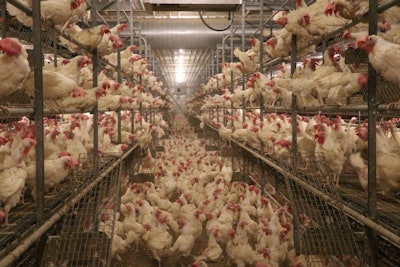
A combination of state legislation driven by ballot initiatives and future cage-free egg purchase pledges by major foodservice, food processing and retail companies is driving a gradual conversion of laying hen housing in the U.S. from cage to cage-free systems. This transition is being made in the expectation that cage-free egg demand will increase as cage-free egg mandates, such those in California and Massachusetts, take affect and cage-free egg purchase pledge dates get closer.
Cage-free hen housing predictions
The December 6, 2021, U.S. Department of Agriculture (USDA) Cage-Free Shell Egg Report estimates that on December 1, 2021, the total U.S. cage-free layer flock had 94.3 million hens, a 14.2 million head increase from the same date in 2020. Cage-free hens now make up around 28.8% of the total U.S. table egg-laying flock.
State cage-free layer housing mandates and most future cage-free egg purchase pledges have implementation dates by January 2025 or earlier. Egg Industry’s annual Top Egg Company survey has asked major U.S. egg producers how they think the nation’s hens will be housed in 2025 each year since the 2015 survey. This year’s survey is the first time that egg producers predict that over half of the nation’s hens will be housed cage-free in 2025 (Figure 1). The average of the 37 responses to this question was that U.S. hens would be housed 50.8% cage free, 48.5% in conventional cages and 0.6% in enriched cages in 2025 (Figure 2). For this prediction to be realized, additional cage-free housing for approximately 75 million hens would need to be constructed or converted over the next three years, nearly doubling the rate of construction and conversion realized over the past 12 months.
The combination of legislation in states that have passed cage-free hen housing mandates and future cage-free egg purchase pledges by major egg purchasing companies, if these are all honored, would require more than 60% of U.S. hens to be housed cage-free from 2025 on. This level of cage-free house construction or conversion will not take place by 2025 due to uncertainty that purchase pledges will be honored and the negative impact this has on availability of financing for conversion or new construction.
Egg producers were asked to predict how the nation’s laying hen flock would be housed in 2030. The simple average of the 37 responses was that U.S. laying hens would be housed 66% cage-free and 34% in cages in 2030 (Figure 3).
Egg producers were also asked to predict how their own company’s hens would be housed in 2030. The 37 responses to this question were compiled as a weighted average based on the company’s current total number of hens housed. Egg producers predict that their own hens will be housed 28.8% in cages, 63.8% cage-free and 7.5% free range in 2030 (Figure 4).
U.S. egg producers were asked if they thought the country’s hens would be housed 100% cage free in 2040. More than three-quarters (76%) of the 37 respondents to this question said no, there will be some laying hens housed in cages in 2040 (Figure 5).
What will drive cage-free conversions?
Egg producers were asked to choose the answer that they believed to best complete the statement, “I think that the biggest driver for cage-free housing in my company will ultimately be ... ” Forty egg producers answered this question; 62.5% of respondents believe legislation in the states where their customers are located will be the primary driver for cage-free housing. The next most common answer was consumer preference for cage-free eggs at 22.5%. Purchase pledges by major egg purchasers in states without cage-free housing legislation was predicted to be the least important factor for driving cage-free housing in their operation, with 15% of respondents choosing this answer.
New construction and cage-free conversions
Top Egg Company survey respondents report building new housing for 9.83 million cage-free hens without outdoor access in 2021. These companies also added total housing for 0.36 million cage-free hens with outdoor access in 2021. In 2022, survey respondents expect to add housing for 12.85 million cage-free hens without outdoor access and for 0.60 million cage-free hens with outdoor access (Table 1).
In 2021, survey respondents report closing or tearing down housing for 7.37 million cage-housed hens and they plan to close or tear down housing for 6.45 million cage housed hens in 2022. to cage-free housing for 5.39 million hens. Survey respondents report plans for converting housing for 4.15 million cage-housed hens to housing for 5.11 million cage-free hens in 2021 (Table 2).
About the survey
The Top Egg Company survey is conducted annually by WATT Global Media, and the results reported are composed of a combination of company-submitted information and estimates made based on input from publicly reported information and industry sources. A total of 43 egg producers who own or contract the production of 218.41 million hens responded to the survey and only responses submitted by egg producers are reported in this article. The Top Company Survey estimates that the 67 largest U.S. egg producers housed 344.72 million hens on December 31, 2021.

















